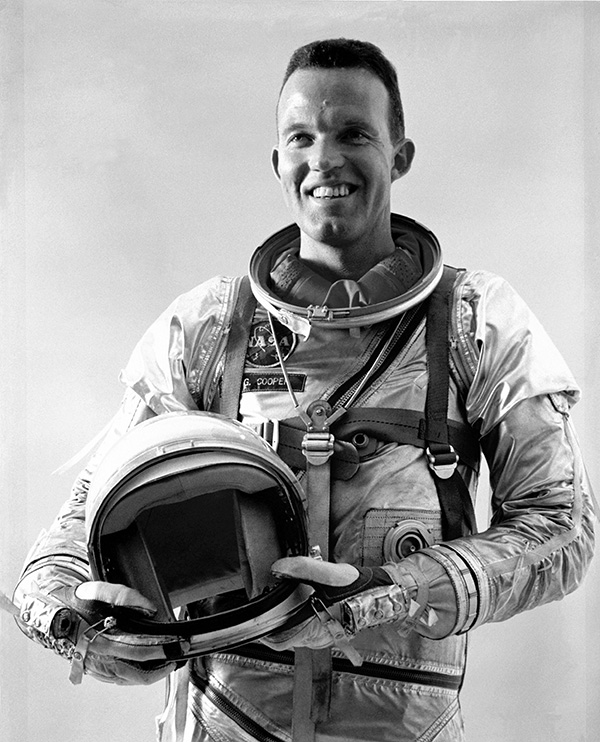The Encyclopedia of Oklahoma History and Culture
COOPER, LEROY GORDON, JR. (1927–2004).
Leroy Gordon Cooper, Jr., was born in Shawnee, Oklahoma, on March 6, 1927. His father sparked a love of flight when he took the five-year-old up in a Curtis Robin monoplane from Regan Airport just outside of Shawnee. By age eight Cooper was flying the family plane, and by age twelve he had flown solo. Cooper worked at the airport to earn money for flying. The aviation community was a close-knit group, and famous aviators would stop by. In that way he got to know aviation legends such as Amelia Earhart, Roscoe Turner, and Wiley Post. Cooper played halfback on the Shawnee High football team and ran sprints and quarter-mile in track. Joining the marines during World War II, he eventually served as part of the Presidential Honor Guard.
In 1949 Cooper transferred to the U.S. Air Force so that he could fly. Not only did he get to fly, but he also pursued his degree in aeronautical engineering from the Air Force Institute of Technology, earning a bachelor's degree in 1956. He flew F-84s and F-86s in the Eighty-Sixth Fighter Bomber group in Munich. He then flew numerous flights as a test pilot in the Flight Test Division at Edwards Air Force Base in California. In April 1959 the National Aeronautics and Space Administration (NASA) selected Leroy Gordon Cooper, Jr., to be one of the original seven Mercury astronauts. He and the other six would represent the United States in the battle for control of space. The perception that the Soviet Union could control space was real. Americans worried about Soviets flying overhead in space and spying or having the capability to bomb the United States.
The Mercury astronauts were heroes in the new Cold War. Cooper piloted Faith 7, the last Mercury flight and the longest one, on May 15–16, 1963. He flew for thirty-four hours and twenty minutes on the twenty-two-orbit mission. He proved the value of humans in space when he had to manually control the spacecraft on reentry after all automatic controls failed. As command pilot on Gemini 5, Cooper and pilot Charles Conrad spent eight days in space from August 21 to 29, 1965. The long-duration mission proved that humans could survive in space long enough for a round trip to the Moon. On this flight Cooper and Conrad also tested fuel cells, a new power source for future flights. In 1969 Cooper served as backup commander to fellow Oklahoman and astronaut Thomas Stafford on Apollo 10.
After logging 222 hours in space, Cooper retired as a colonel from the U.S. Air Force, as well as from his career at NASA in 1970. As well as serving as a consultant, after retiring he served on the board of directors of several companies. Cooper received the Air Force Distinguished Flying Cross, the Air Force Legion of Merit, the NASA Exceptional Service Medal, the NASA Distinguished Service Medal, the Collier Trophy, and the Harmon Trophy, among others. He died on October 4, 2004, in Ventura, California.
See Also
GERALDYN M. COBB, OWEN K. GARRIOTT, WILLIAM REID POGUE, JACKIE LINWOOD RIDLEY, THOMAS PATTEN STAFFORD
Learn More
Leroy Gordon Cooper, Jr., Leap of Faith (New York: Harper Collins Books, 2000).
Dick Lattimer, All We Did Was Fly to the Moon (Gainesville, Fla.: Whispering Eagle Press, 1983).
Citation
The following (as per The Chicago Manual of Style, 17th edition) is the preferred citation for articles:
Bill Moore, “Cooper, Leroy Gordon, Jr.,” The Encyclopedia of Oklahoma History and Culture, https://www.okhistory.org/publications/enc/entry?entry=CO052.
Published January 15, 2010
© Oklahoma Historical Society


